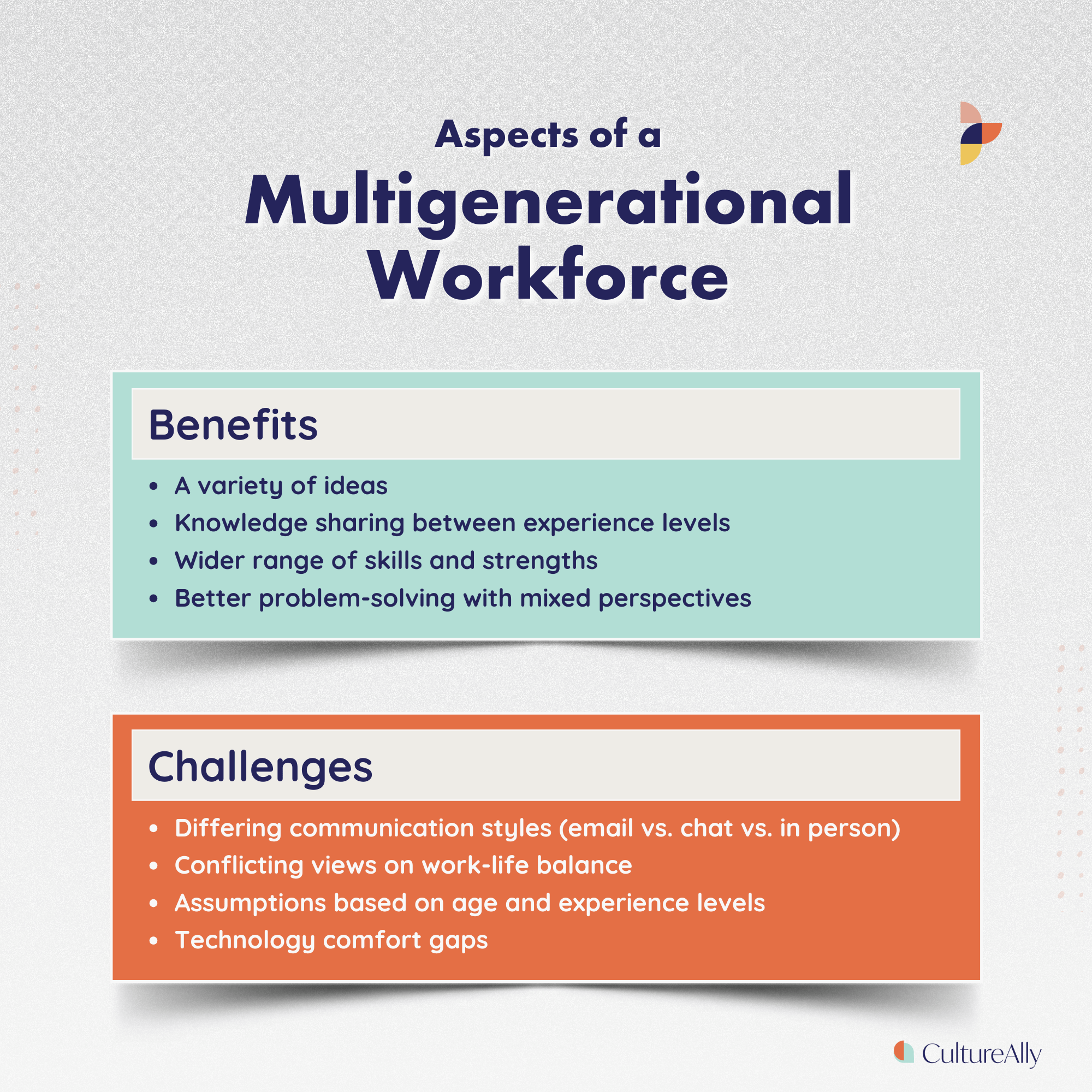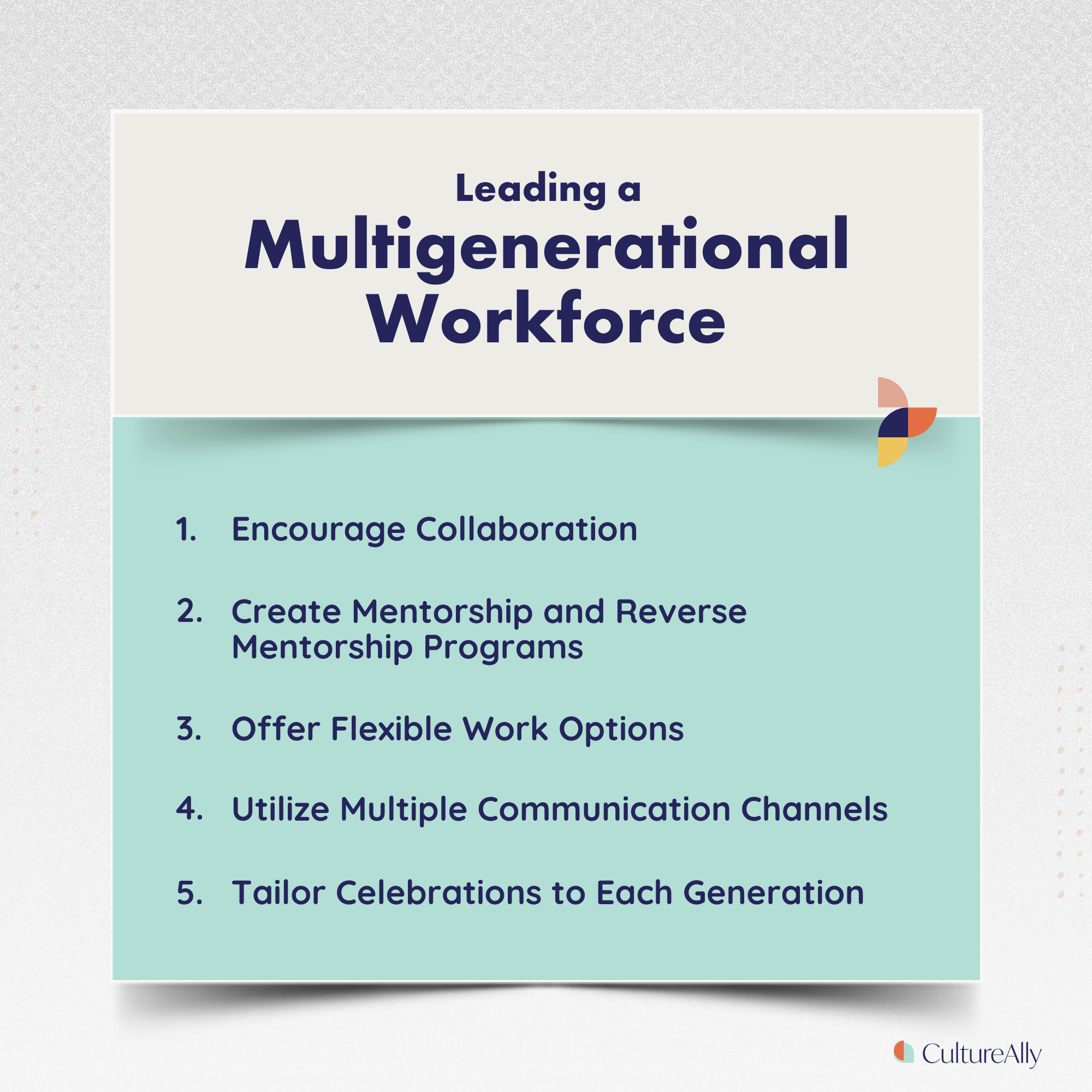Navigating the Dynamics of a Multigenerational Workforce in 2025
Today’s workforce is more age-diverse than at any other point in history. Many organizations now employ five generations side by side: from late-career professionals with decades of expertise to early-career employees beginning their first full-time roles. This overlap can be a powerful advantage, but it can also reveal competing expectations around communication, career growth, work–life balance, and technology.
Discussions around generational dynamics used to focus on stereotypes: Millennials were labeled entitled, Gen Z distracted, Baby Boomers inflexible. But in 2025, it’s clear that the real story isn’t one of conflict, it’s about adaptation. Employees of all ages are navigating rapid shifts in work norms, hybrid structures, economic pressures, and evolving cultural expectations. Which is to say: age alone doesn’t tell the whole story.
Rather than asking how generations are different, the more useful question is: How can leaders create workplaces where each generation’s experience becomes an asset?
In this blog we’ll explore:
What Is a Multigenerational Workforce?
A multigenerational workforce describes a cohort of employees that spans various age groups, from young to old and everyone in between.
In modern workplaces, this variety of age ranges takes on additional importance. Diversity in age and experience leads to notable differences among coworkers, stemming from their distinct life backgrounds. While substantial advantages come from this variety, it is important to implement effective strategies to manage cross-generational workforces to prevent any potential issues from arising.
Understanding the Generations
Generational categories can be helpful in understanding broader social trends, but they should never be treated as fixed personality types. Not everyone born in the same decade shares values, habits, or ambitions. Still, these groupings offer a useful lens for workplace experiences shaped by historical context.
| Generation | Birth Range (Approximate) | Influences |
|---|---|---|
| Baby Boomers | 1946 – 1964 | Economic expansion, hierarchy, long-term stability |
| Generation X | 1965 – 1980 | Transitional tech era, independence, self-reliance |
| Millennials | 1981 – 1996 | Digital emergence, 9/11, recession, purpose-driven work |
| Generation Z | 1997 – 2012 | Digital natives, social activism, pandemic-era education |
| Gen Alpha (Emerging) | 2013+ | Fully born into AI, mobile-first world |
Important Note: These categories are trends, not labels for individuals. Many individuals don’t identify strongly with their “assigned” generation, and lived experience varies widely across cultures and identities.
The Strengths of a Multigenerational Workforce
A multigenerational workplace, when supported properly, offers major strategic advantages:
1. Broader Perspective and Problem-Solving
Different career stages bring distinct ways of thinking. Some employees draw on lived experience and institutional memory, while others bring fresh concepts or unconventional tools. This variety fuels innovation.
2. Knowledge Continuity and Mentorship
Tenured workers carry valuable historical knowledge and insights into what has succeeded or failed, and why. When paired with newer hires, organizations can maintain continuity while moving forward.
3. Enhanced Market Insight
A team that spans generations is more likely to understand and empathize with a wide customer base, particularly in industries touching multiple age demographics.
4. Stronger Learning Cultures
Cross-generational collaboration encourages reciprocal learning. This could mean teaching leadership development, technology nuances, strategic thinking, or emerging platforms.
5. Organizational Resilience
Employees who’ve weathered different economic cycles and disruptions can help one another navigate volatile conditions. The pandemic underscored the value of intergenerational adaptability.
Challenges of Multigenerational Workforces in 2025
Generational tension isn’t new, but the nature of it has evolved. Today’s pain points are less about clashes in personality and more about differences in expectations at work.
These include:
1. Communication Norms
Some employees prefer scheduled meetings and formal emails; others communicate through messages, emojis, or voice notes. When it comes to major communication differences in regards to older generations (i.e., Baby Boomers and Gen-X), tones can be easily misread, especially over text, and brevity may come across as dismissive while informality may seem unprofessional.
On the other hand, as older folks retire the workforce is being replaced by Gen-Z, Millennials, and Gen Alpha individuals. And when it comes to these younger generations, it’s important to focus on what leads to the most productive, happy employees as well. This might mean:
Utilizing more chat-based programs like Slack, Discord, or G-Chat for quick messages and updates;
Understand that Gen-Zs and younger are seen as hypercognitive, meaning they are comfortable with cross-referencing information;
Prioritize transparency and plain, albeit kindly delivered, information and truth.
2. Expectations Around Flexibility
For some, career success is synonymous with office presence and visibility. For others, remote or hybrid flexibility is non-negotiable. These mismatches can create unintended resentment between generations, who may have different perceptions of productivity.
3. Technology Habits and Digital Pace
When it comes to technology habits, it’s not so much if workers can use technology effectively; rather, it’s about differences in digital preferences and pace. Tools change quickly: one day we’re using one program or time tracker and the next those have fallen out of favor.
But finding comfort with constant platform switching can vary wildly, regardless of age and capability.
4. Feedback and Recognition Styles
Feedback expectations are one of the most common (and most misunderstood) points of tension between generations in the workplace. Some employees thrive on frequent check-ins, collaborative goal-setting, and real-time coaching. Others prefer autonomy and receiving feedback in a more regimented way, with check-ins focused on meaningful, specific direction and changes.
These differences are not necessarily age-specific. Often, they are tied to personal work history, industry culture, and psychological safety mechanisms.
For example:
An early career employee may want regular guidance. This isn’t because they lack confidence, but because they want to grow quickly, move up in the workforce, and continue learning.
More seasoned workers may expect trust that is demonstrated via independent, autonomous work. Checking in too often may feel like micromanagement.
Of course, whether or not an employee prefers frequent or infrequent feedback and recognition is unique regardless of their generation. That’s why it’s important to learn your employee preferences via inclusivity reviews and consulting, pulse check surveys, and more.
5. Career Progression and Life Stage Realities
Generational differences often reflect life stage differences.
Younger employees may seek rapid advancement. Mid-career employees may balance caregiving responsibilities. Later-career professionals may prioritize legacy or mentorship. Recognizing and addressing these differences can mean emphasizing mentorship and learning opportunities for some and prioritizing work-life balance differently for others.
6. Implicit Age Bias
Ageism moves in both directions. Dismissive remarks like “You’re too young to understand” or “They’re out of touch” may seem harmless, but they can deeply affect engagement, belonging, and retention.
Strategies for Inclusive Cross-Generational Collaboration
To move beyond generational friction, leaders should aim to design systems that value experiences at all stages of life.
Normalize Multi-Modal Communication Styles
Offer multiple communication channels (e.g., messaging platforms, videos, emails, in-person) and encourage teams to share communication preferences. Clarity should override assumptions.
Quick Tip: Encourage teams to create a shared “communication agreement” outlining norms for responsiveness, tone, and platform use.
Build Reciprocal Mentorship
Move beyond traditional top-down mentorship. Reverse mentorship opportunities where younger employees teach emerging technologies or cultural trends, democratizes knowledge. Pair it with traditional wisdom-sharing practices with top-down mentorship.
Emphasize learning, sharing, and the importance of establishing relationships between generations, with additional emphasis on the idea that everyone has a variety of education and experiences for others.
Individualize Feedback and Recognition
Ask employees what recognition looks like to them. Some may value public acknowledgment; others, private appreciation or developmental opportunities.
Update Leadership Training to Include Age Inclusion
Train managers to recognize and interrupt age-based assumptions. Age bias often goes unaddressed in inclusivity frameworks, but combating phrases like “digital native” or “stuck in their ways” matters.
Create Knowledge-Sharing Mechanisms
Formalize opportunities for cross-generational exchange:
Lunch-and-learn sessions
“Teach me something” days
Shadowing and cross-role exchanges
Design Flexibility With Guardrails
Flexibility must come with structure. Establish shared core hours but allow autonomy around them. Balance asynchronous freedom with intentional connection.
Ultimately, this serves as a way to establish important work-life balance, both for older and younger individuals.
Support Career Development at All Stages
Offer growth pathways for both early- and late-career employees. Senior talent may want mentorship roles or phased retirement transitions. Younger talent may crave stretch assignments and leadership exposure.
Encourage Storytelling Within Teams
Invite people to share milestones, challenges, and “career turning points.”
Storytelling builds empathy, and empathy dissolves stereotypes faster than quick facts by establishing that important personal connection.
Addressing Burnout and Economic Realities
A key modernization in 2025 is acknowledging that generational patterns are heavily influenced by economic realities:
Gen Z faces rising costs of living, wage precarity, and a higher reported rate of burnout.
Millennials often manage dual pressures: career advancement alongside parenting or elder care.
Gen X and Boomers may delay retirement due to financial shifts, caregiving needs, or purpose-driven work.
Supporting mental well-being, financial security, and life-stage transitions is now fundamental to cross-generational inclusion. Age-inclusive strategy is not only about interpersonal dynamics: it’s also about policy and support.
The Future: Beyond Labels
Soon enough, Gen Alpha will enter the workplace. These are adults born fully into a touchscreen generation; however, rather than preparing for “what they’ll be like” with a fearful, apprehensive outlook, a more powerful shift is moving beyond these generational caricatures altogether.
Workplaces of the future won’t thrive because they decode age labels. They will thrive because they build cultures where:
People of all ages have something to teach and learn
Curiosity is valued over certainty
Differences spark innovation rather than tension
Inclusion takes life stage into account, not just demographic boxes
The goal isn’t to prevent conflict. It’s to design environments where friction becomes fuel for growth.
Conclusion: From Generations to Growth
A multigenerational workforce is not a challenge to be managed.
Instead, think of it as an advantage to be activated. When employees of different ages come together with respect, curiosity, and shared purpose, workplaces become smarter and more resilient.
What makes the difference is not age. It’s whether organizations make room for every generation to contribute, evolve, and lead.
Quick FAQ: Navigating the Dynamics of Multigenerational Workforce
-
The biggest tension typically stems from differences in communication styles, flexibility, and feedback preferences rather than personality clashes. Misunderstandings often arrive from assumptions rather than actual disagreement.
-
Many leaders worry about conflict between age groups. However, when supported, multigenerational teams assist each other by knowledge-sharing to create innovative ideas, improving resilience. The key is designing systems that let each generation’s experience contribute meaningfully.
-
Avoid blanket statements. For example, saying things like “Gen Z is lazy” or “Boomers hate change” are not meant to challenge stereotypes or build teams, but rather work to divide them.
Instead, focus on individual preferences around communication, feedback, and flexibility. Ask employees directly what helps them work at their best rather than assuming based on age.
To learn more, check out our Multigenerational Workforce training today.


